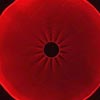Wrinkling, Crumpling and Folding
J-C, Geminard, R. Bernal, Ch. Tassius, F. Melo
Here the question that we want to address is: Are some characteristics of the wrinkles likely to inform us about the forces, applied by the cell to the substrate.
In order to answer the question above, we study the formation of wrinkles in a thin elastic membrane 0.2mm thick made of latex and stretched on a circular frame of 50cm in diameter (Fig.1). A well-defined radial displacement, and thus the radial force, is imposed along a circle at the center of the membrane. The detailed analysis of the resulting pattern shows that the length of the wrinkles is likely to inform us about the forces, more than their wavelength.

One observes the formation of radial wrinkles (12 in this example) around the circle along which the membrane is pulled to the centre (bright circle around the dark disk). For a given radius of the circle, the number of wrinkles is constant, whereas their length depends linearly on the applied force above a well defined threshold.